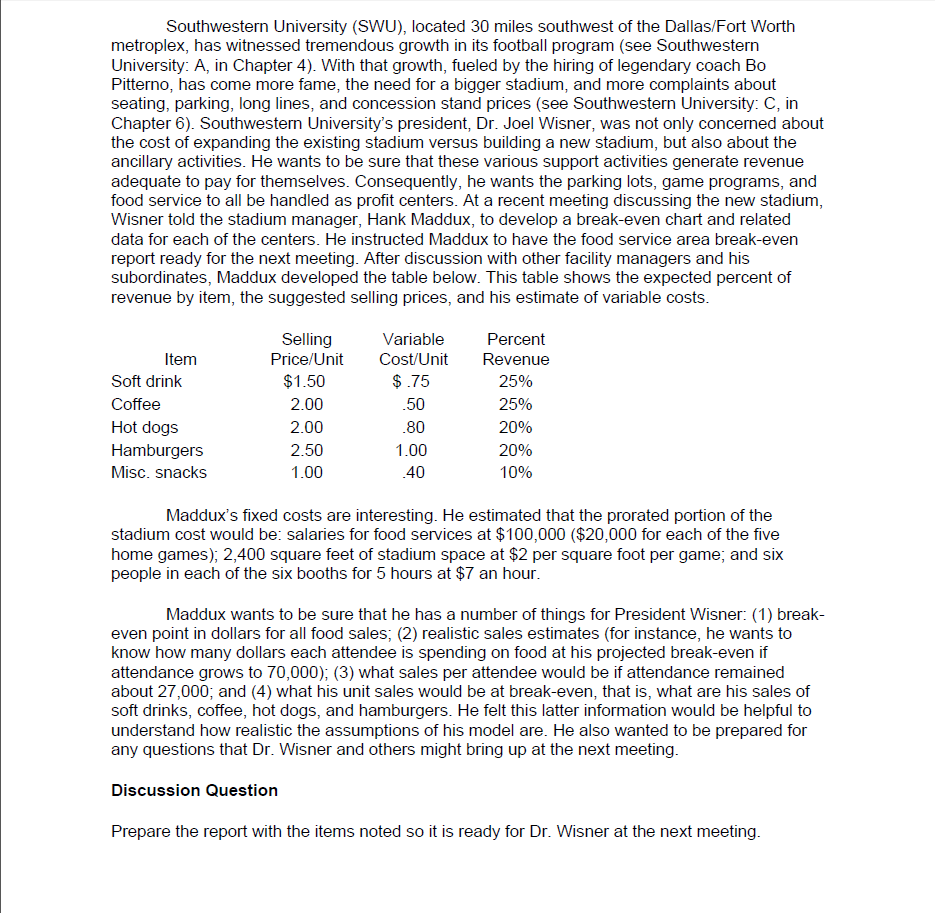Case Study report
Southwestern University (SWU), located 30 miles southwest of the Dallasl'Fort Worth metroplex, has witnessed tremendous growth in its football program (see Southwestern University: A, in Chapter 4}. With that growth, fueled by the hiring of legendary coach Bo Pittemo, has come more fame, the need for a bigger stadium, and more complaints about seating, parking, long lines, and concession stand prices (see Southwestern University: C, in Chapter 6). Southwestern University's president, Dr. Joel Wisner, was not only concemed about the cost of expanding the existing stadium versus building a new stadium, but also about the ancillary activities. He wants to be sure that these various support activities generate revenue adequate to pay for themselves. Consequently, he wants the parking lots, game programs, and food service to all be handled as prot centers. At a recent meeting discussing the new stadium, Wisnertold the stadium manager, Hank Maddux, to develop a breakeven chart and related data for each of the centers. He instructed Maddux to have the food service area breakeven report ready for the next meeting. After discussion with other facility managers and his subordinates, Maddux developed the table below. This table shows the expected percent of revenue by item, the suggested selling prices, and his estimate of variable costs- Selling Variable Percent Item Pn'cer nit Costhnit Revenue Soft drink $1.50 $ .?5 25% Coffee 2.00 .50 25% Hot dogs 2.00 .80 20% Hamburgers 2.50 1 .00 20% Misc. snacks 1.00 .40 10% Maddux's xed costs are interesting. He estimated that the prorated portion of the stadium cost would be: salaries for food services at $100,000 ($20,000 for each of the live home games); 2,400 square feet of stadium space at $2 per square foot per game; and six people in each of the six booths for 5 hours at 3;? an hour. Maddux wants to be sure that he has a number of things for President Wisner: (1} break even point in dollars for all food sales; (2) realistic sales estimates (for instance, he wants to know how many dollars each attendee is spending on food at his projected breakeven if attendance grows to ?0,000); (3)- what sales per attendee would be if attendance remained about 2?,000; and (4) what his unit sales would be at breakeven, that is, what are his sales of soft drinks, coffee, hot dogs, and hamburgers. He felt this latter information would be helpful to understand how realistic the assumptions of his model are. He also wanted to be prepared for any questions that Dr. Wisner and others might bring up at the next meeting. Discussion Question Prepare the report with the items noted so it is ready for Dr. Wisner at the next meeting







